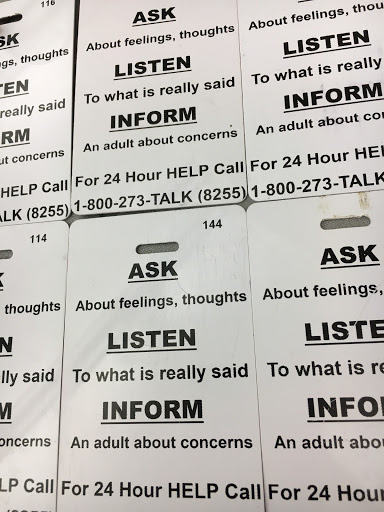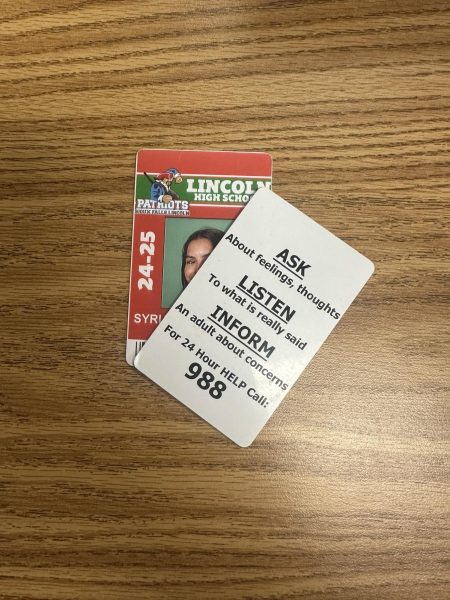Ask, listen, uninformed

LHS’ student id’s for the 2018-19 school year
School assemblies are more commonly mocked than almost anything at LHS.
From addiction recovery to anti-bullying, the student body will find a way to tear the event apart, justified or not. It seems as though there isn’t a way for the staff to win when it comes to gathering students to discuss serious topics, but in this case, there might be a valid reason for the students’ backlash.
On Thursday, September 6, assemblies were held for the freshman and sophomore classes to discuss help for students who experience suicidal tendencies. It was made clear that in LHS’ 2018-19 school year, the staff would make an effort to release the stigma around mental health. Despite their attempts, the assembly left a considerable amount of the lower classmen upset and unsatisfied.
“It’s great that they are bringing attention to mental health, and I think that could help, but I feel like they just kind of gloss over it,” said freshman Isaac Shelton. “They do address mental health but I feel like they don’t go into detail the way they should.”
Along with Shelton, others have expressed concern that the stigma around suicide is just as prevalent as it has ever been. In winter of the 2017-18 school year, the LHS was left in a state of grief and shock following the suicide of a student. When the announcement was made to a class, the students were instructed not to mention the situation to anyone in school and to refrain from posting on social media until the school day had ended. In spite of the staff’s wishes, the news inevitably spread across the school after students noticed their peers’ distress.
“It’s understandable that the school is trying to respect the family [of the deceased], but it’s toxic for information this grave to spread by word of mouth and social media,” said one of the classmates. “It’s hard to be the one to have to look someone in the eyes and tell them that their friend had died.”
In the weeks following the individual’s death, students’ mental health took a nosedive. Students were at liberty to discuss how the situation had affected them with their counselors, but problems arose in that students felt the entire ordeal had been blacklisted. For the students, being denied an open discussion or even any formal acknowledgment from the school contributed to the stigma surrounding suicide. While some were frustrated by the way LHS dealt with the circumstances, it was clear that it was never a matter of the staff’s wishes, but rather that of the Sioux Falls School District and its policies.
After emailing the Sioux Falls School District on whether or not there were any official policies regarding student death, no real conclusion was reached. And while the district seemingly has no real policy when it comes to addressing suicide, plenty of advice for schools has been provided online from organizations such as the Society for the Prevention of Teen Suicide (SPTS). Organizations like the SPTS encourage schools to memorialize students who have passed away. In cases of suicide, however, they push for the opposite action to be taken.
According to their website, there is research about “media coverage of suicides that found that sensationalized news coverage contributed to copycat deaths. Experts…support the common sense observation that vulnerable students who are at risk for suicide may be affected by memorial tributes…While the logic of dying by suicide so that the school will put up a plaque or hold an assembly to acknowledge the death is almost impossible for most [people] to comprehend, it is the way suicidal students can think.”
The SPTS makes the valid point that society tends to glorify those who have committed suicide. At the same time, treating suicidal children as nothing more than victim-players crazy enough to die for a locker plaque makes them look as if they lack such an understanding for adolescents that they watched “Heathers” without realizing it was a comedy.
With fall beginning and nearly a full school year ahead, students’ mental health will inevitably spiral the way it does every year. Counselors and the rest of the LHS staff deserve credit for their attempts to get students the help they need, even if those attempts backfired. No matter how hard they try, adults will never be able to understand today’s teen suicide issue the way the actual teenagers can. Both students and staff have a long way to go before they can meet in the middle, but the path has been paved for an open discussion on what is really going on, and it starts with the truth. What LHS’ staff may not have considered is that suicidal students often keep their struggles to themselves in fear of their loved ones not understanding, and when confidentiality with a counselor is broken, so is their trust.
This school year, instead of the students sitting back and criticizing the adults’ unsuccessful attempts at solutions, the time has come for them to speak their minds about why this system goes wrong and what needs to be done differently. No single person holds the answers to this problem; progress begins when the exact problems are brought to the surface. It seems like a distant fantasy, but just as these struggling kids will come to realize, there is a light at the end of the tunnel.
Correction: 10/3/18
This article contained minor formatting errors, but they have since been corrected.

Mara Fendrich is a senior and third-year staff member of the Statesman. During the school day, she can be found waving vigorously at everyone she knows...






